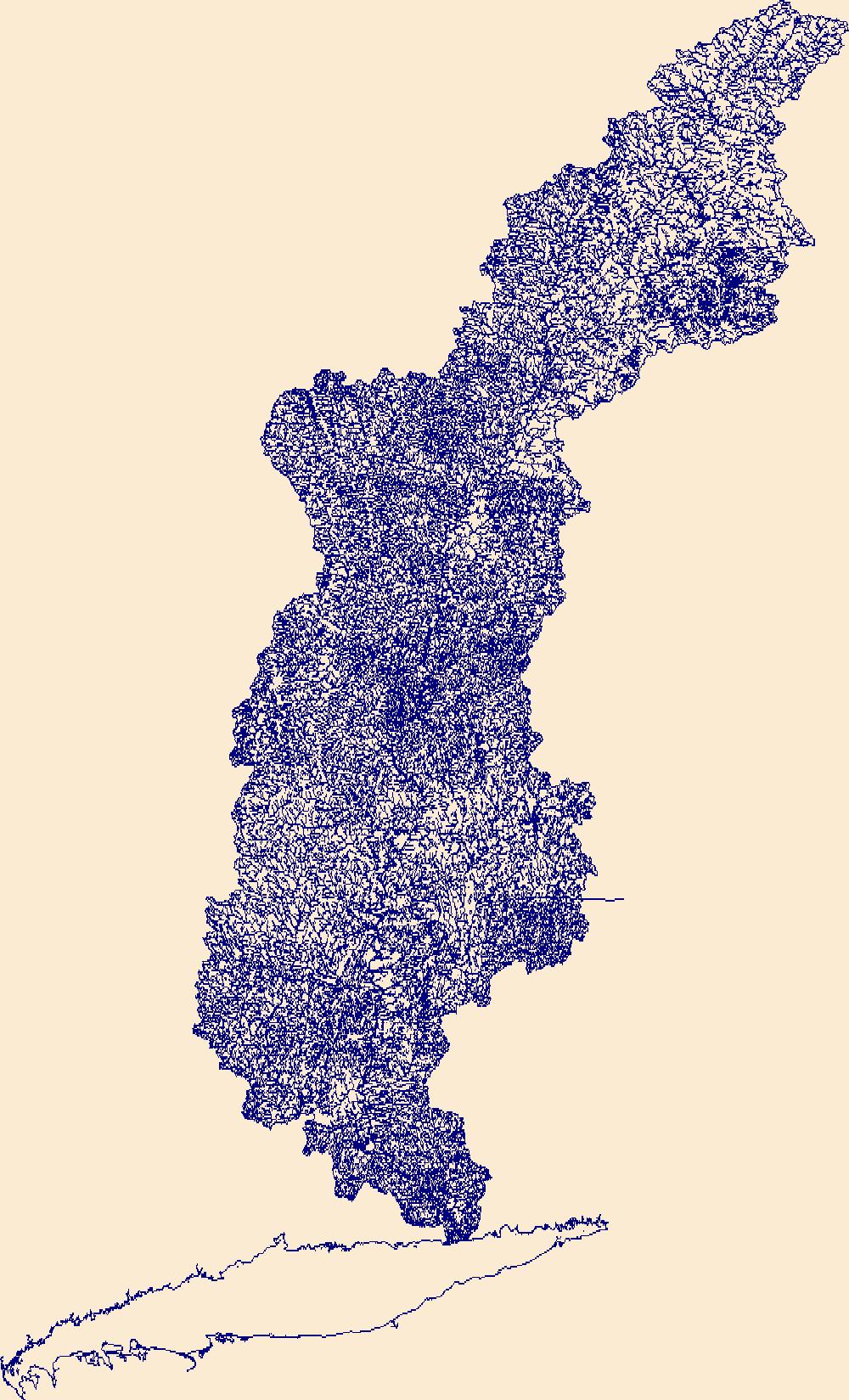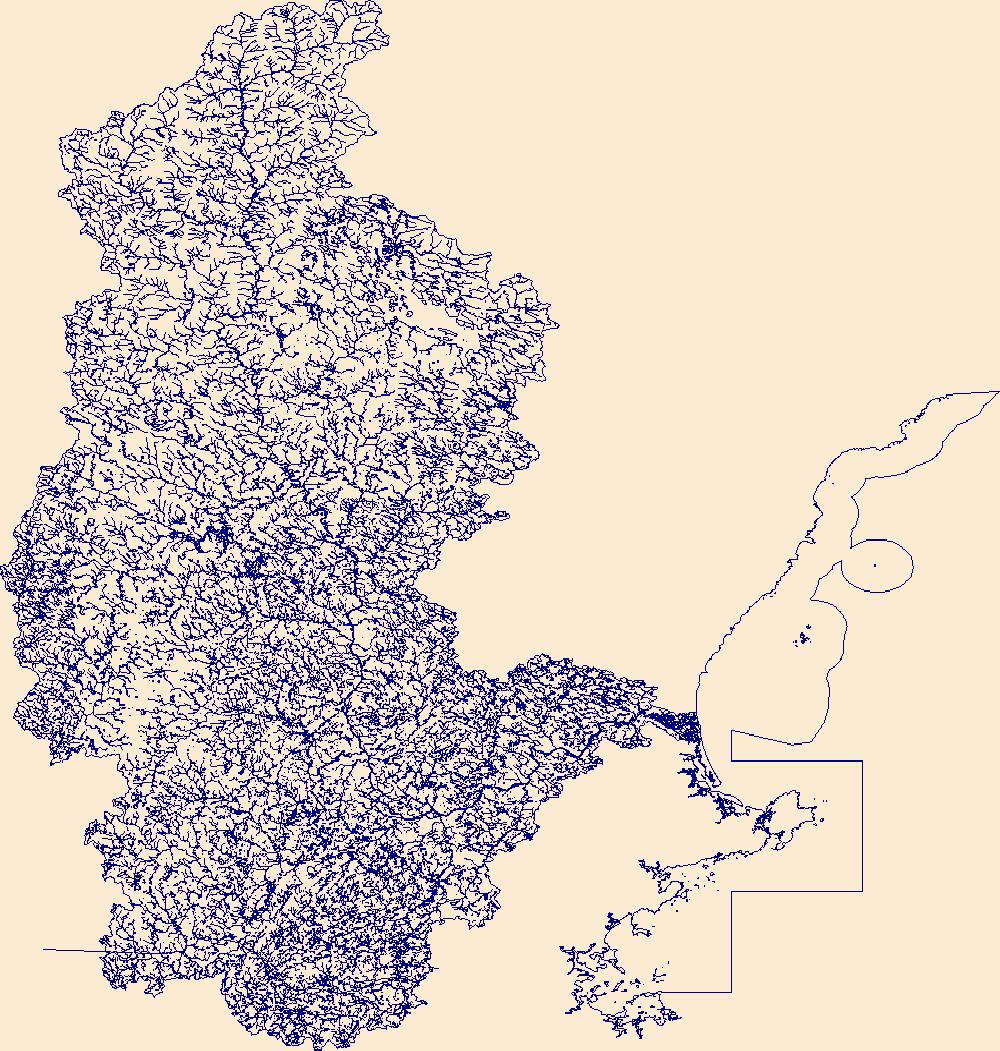Filters: Tags: Surface Water Quality (X)
348 results (13ms)|
Filters
Date Range
Extensions Types Contacts
Categories
Tag Types
|
This dataset contains watershed means of estimated percent impervious surfaces for three time periods: 1992, 2002, and 2012. Estimates are based on coefficients derived from comparing land use of the 2012 NAWQA Wall-to-wall Anthropogenic Land-use Trends (NWALT) product to the 2011 National Land Cover Database (NLCD) imperviousness, then applying those coefficients to previous years (1974-2002) of the NWALT dataset.
Categories: Data;
Types: Citation;
Tags: Chesapeake Bay,
Delaware,
District of Columbia,
James River,
Maryland,
The dataset contains estimates for total phosphorus flux from wastewater treatment plants that discharge to surface water within the Red River of the North Basin in the United States and subbasins. Shapefiles defining the subbasins are available as part of the same data release in which these data are published. Estimates of wastewater treatment plant total phosphorus flux (or load) were calculated by Tammy Ivanhnenko for the years 1978, 1980, 1982, 1984, 1986, 1988, 1990, 1992, 1996, 2000, 2004, 2008, and 2012. Flux estimates were based on the average discharge from the wastewater treatment plants and treatment level, both reported as part of the U.S. Environmental Protection Agency's Clean Watershed Needs Survey,...

The Eagle River drains approximately 970 square miles (sq mi) west of the Continental Divide in central Colorado before flowing into the Colorado River. The Eagle River watershed (ERW) is located primarily within Eagle County and includes the towns of Vail, Minturn, Avon, Edwards, Eagle, and Gypsum. The eastern boundary of the ERW is drained by Gore Creek, located at Vail Pass. Gore Creek flows along I-70 through the town of Vail before its confluence with the main stem Eagle River near the town of Minturn. The Eagle River continues to flow along I-70 to its western boundary near Dotsero. Increased tourism and development in Eagle County is in part due to the high mountain environment and accessible location within...
Toxic contaminants and naturally occurring substances found in the subsurface can exist in multiple phases, and undergo complex reactions including biodegradation. A comprehensive and quantitative understanding of the processes controlling the fate and transport of subsurface contaminants is necessary to develop policies and strategies for managing water-quality conditions in different land use and environmental settings. Numerical models that simulate flow, transport, and reactions are useful tools for understanding the fate of chemicals in the subsurface when used in conjunction with field and laboratory studies. The research efforts of this project consider flow and chemical behavior in the saturated and unsaturated...
Categories: Project;
Tags: Rivers and Streams,
Solute Transport,
Solute Transport,
Surface Chemistry,
Surface Water Quality,
Several canals in southern Florida run from Lake Okeechobee through the Everglades Agricultural Area (EAA) and feed water to the northern Everglades. Agricultural and water-management practices affect the water quality of these canals. Fertilizers added in the EAA flow into the canals and are transported to treatment areas which remove much of the phosphorous in the water, but are not as effective in removing dissolved sulfate. Elevated sulfate concentrations, found downstream in the Water Conservation Areas in the northern Everglades, can stimulate sulfur-reducing bacteria which can also convert inorganic mercury to methyl mercury, a bioaccumulative neurotoxin. Chemistry data at 25 canal sites in southern Florida...
Categories: Data;
Tags: Broward County,
Energy Resources,
Geochemistry,
Miami-Dade County,
Palm Beach County,
These data were compiled to create models that estimate entrainment rates and population growth rates of smallmouth bass below Glen Canyon Dam. Objective(s) of our study were to predict smallmouth bass entrainment rates and population growth under different future scenarios of Lake Powell elevations and management. These data represent parameters needed for associated models and data needed to produce figures. These data were collected from publicly available online sources including published papers and federal government datasets. These data were assembled by researchers from U.S. Geological Survey, Utah State University, Colorado State University, U.S. Fish and Wildlife Service. These data can be used to run...
From August 2018 to October 2019, the U.S. Geological Survey collected spatially high-resolution water quality data as part of five shoreline synoptic surveys around the perimeters of Owasco, Seneca, and Skaneateles Lakes within the Finger Lakes Region of New York. Water-quality data were collected just below water surface utilizing YSI EXO2 multiparameter sondes and portable nitrate sensors paired with real-time GPS data as part of a HABs monitoring program in the Finger Lakes. In October 2019, water-quality data collection was paired with discrete phytoplankton grab samples on Owasco Lake and Seneca Lake. Phytoplankton grab samples were collected just below water surface with a peristaltic pump at twelve locations...
Types: Map Service,
OGC WFS Layer,
OGC WMS Layer,
OGC WMS Service;
Tags: Aquatic Biology,
Contaminants, HABS,
Finger Lakes,
Limnology,
New York,
This child item data set provides high-resolution, nearshore, spatial water-quality data collected from Owasco Lake, New York, on June 26 and October 8, 2019. All data are reported as raw measured values. Continuous water-quality monitors were mounted to a boat at approximately 0.5-meters below the water surface and used to measure nitrate, chlorophyll fluorescence (fChl), fluorescent dissolved organic matter (fDOM), dissolved oxygen, specific conductance, phycocyanin fluorescence (fPC), turbidity, pH, and temperature.
Categories: Data;
Tags: Contaminants, HABS,
Finger Lakes,
New York,
Owasco Lake,
Surface-Water Quality Monitoring,

The High Resolution National Hydrography Dataset Plus (NHDPlus HR) is an integrated set of geospatial data layers, including the National Hydrography Dataset (NHD), National Watershed Boundary Dataset (WBD), and 3D Elevation Program Digital Elevation Model (3DEP DEM). The NHDPlus HR combines the NHD, 3DEP DEMs, and WBD to a data suite that includes the NHD stream network with linear referencing functionality, the WBD hydrologic units, elevation-derived catchment areas for each stream segment, "value added attributes" (VAAs), and other features that enhance hydrologic data analysis and routing.

The High Resolution National Hydrography Dataset Plus (NHDPlus HR) is an integrated set of geospatial data layers, including the National Hydrography Dataset (NHD), National Watershed Boundary Dataset (WBD), and 3D Elevation Program Digital Elevation Model (3DEP DEM). The NHDPlus HR combines the NHD, 3DEP DEMs, and WBD to a data suite that includes the NHD stream network with linear referencing functionality, the WBD hydrologic units, elevation-derived catchment areas for each stream segment, "value added attributes" (VAAs), and other features that enhance hydrologic data analysis and routing.
Weighted Regressions on Time, Discharge and Season (WRTDS) and WRTDS with Kalman filtering (WRTDS_K) models were developed for total and dissolved cadmium, zinc and lead; total phosphorus and nitrogen; and dissolved orthophosphate at twelve sites in the Spokane River watershed, northern Idaho, for water years 1990 to 2018. The data table contains the annual mean concentrations and annual total loads estimated by WRTDS_K, and the flow-normalized annual mean concentrations and flow-normalized annual total loads estimated by WRTDS for each modeled site and constituent.
This U.S. Geological Survey (USGS) data release contains the data used in the USGS Scientific Investigations Report 2018-5053 entitled "An exploratory Bayesian network for estimating the magnitudes and uncertainties of selected water-quality parameters at streamgage 03374100 White River at Hazleton, Indiana, from partially observed data." The four datasets, which contain only ASCII characters in a column-oriented format, are: (1) sel_qw_parm_full_time_series.csv: A comma-delimited file containing an irregular time series of 713 rows of discrete water-quality measurements that start on February 21, 1973 and end on September 14, 2016. (2) baye_network_initialize.cas: This tab-delimited file can be used to initialize...
Three regression models were developed for describing variability of host-specific flux data in eight Great Lakes tributaries. Models include one for Lachnospiraceae flux, one for human bacteroides flux, and one for ruminant bacteroides flux. Models were developed using the R project for statistical computing with core functionality and the survival, smwrBase, and smwrQW packages. Predictor variables for these models are included in the data file and input files provided. These include sampling dates and times, rainfall depth, percent of watershed underlain by tile drainage, cattle population (for the ruminant marker model) and human population (for the human marker models). Sample collection and laboratory analyses...
Categories: Data;
Tags: Bacteria,
Great Lakes Region,
Regression analysis,
Surface water quality,
USGS Science Data Catalog (SDC)
This dataset includes pesticides and pesticide transformation products in 15 tributaries of the Great Lakes. Pesticides were monitored using polar organic chemical integrative samplers (POCIS) to estimate concentrations in water following standard protocols (Alvarez, 2010) in June and July 2016. POCIS extracts were analyzed for 225 chemicals (USGS National Water Quality Laboratory schedule 5437, Sandstrom and others, 2016), for which 129 chemicals also have POCIS uptake rates, allowing calculations of time-weighted mean concentration over the approximately 30 day deployment (Alvarez and others, 2008). Collectively, there were 97 chemicals detected, and time-weighted mean concentrations could be calculated for 95...
This dataset describes the quantity, morphology, and polymer identity of microplastics in the water column and surficial sediments of Milwaukee-Area streams, the Milwaukee Harbor, and Lake Michigan (Wisconsin). Water samples were collected at 10 locations, 2-4 times each, from May to September, 2016. At the 4 shallowest locations, water was collected only at the water surface. At the remaining 6 locations, water was collected at the water surface and at 1-4 depths below the surface. Sediment samples were collected once, in June 2016, at a subset of 9 locations. Sampling and analysis methods are described in the Processing Steps section of the metadata. These data are interpreted in the following journal article:...
Categories: Data;
Tags: Environmental Health,
Hydrology,
Lake Michigan,
Milwaukee,
USGS Science Data Catalog (SDC),

The High Resolution National Hydrography Dataset Plus (NHDPlus HR) is an integrated set of geospatial data layers, including the National Hydrography Dataset (NHD), National Watershed Boundary Dataset (WBD), and 3D Elevation Program Digital Elevation Model (3DEP DEM). The NHDPlus HR combines the NHD, 3DEP DEMs, and WBD to a data suite that includes the NHD stream network with linear referencing functionality, the WBD hydrologic units, elevation-derived catchment areas for each stream segment, "value added attributes" (VAAs), and other features that enhance hydrologic data analysis and routing.

The High Resolution National Hydrography Dataset Plus (NHDPlus HR) is an integrated set of geospatial data layers, including the National Hydrography Dataset (NHD), National Watershed Boundary Dataset (WBD), and 3D Elevation Program Digital Elevation Model (3DEP DEM). The NHDPlus HR combines the NHD, 3DEP DEMs, and WBD to a data suite that includes the NHD stream network with linear referencing functionality, the WBD hydrologic units, elevation-derived catchment areas for each stream segment, "value added attributes" (VAAs), and other features that enhance hydrologic data analysis and routing.
This data release contains dissolved cyanotoxin concentrations for microcystins (MC), cylindrospermopsins (CYL), anatoxins (ATX), and saxitoxins (STX) assessed using enzyme-linked immunosorbent assays (ELISA) and liquid chromatography-mass spectrometry or tandem mass spectrometry (LC-MS and LC-MS/MS, respectively) in extracts from SPATT (n=95) and DGT samplers (n=10) deployed on three Finger Lakes (Owasco, Seneca, and Skaneateles) between June and November 2019. Relative percent contributions of microcystin congeners are also provided for samples analyzed by LC-MS and LC-MS/MS. Solid phase adsorption toxin tracking (SPATT) and diffusive gradients in thin-films (DGT) are types of passive environmental samplers containing...
Categories: Data;
Types: Map Service,
OGC WFS Layer,
OGC WMS Layer,
OGC WMS Service;
Tags: Contaminants, HABS,
Finger Lakes,
New York,
Owasco Lake,
Owasco Lake Platform (Site ID: 425327076313601),
Over 300 samples were collected in New York, Vermont, and Massachusetts from wastewater treatment facilities (20 locations), drinking water facilities (9 locations), streams (53 locations), lakes (2 locations), a bay (1 location), and a POCIS (Polar Organic Chemical Integrative Sampler) blank sample between April 2009 and October 2018. This data release provides chemistry data for over 400 analytes, including pharmaceuticals, hormones, personal care and domestic use compounds, pesticides and other compounds using 10 different laboratory analytical methods on water, sediment, wastewater sludge, and POCIS samples. Quality assurance data, such as equipment and field blank data and percent recovery for isotopic dilution...
Categories: Data;
Tags: Contaminants, Emerging,
Contaminants, Organic,
Environmental Quality,
Massachusetts,
New York,
SPARROW model dataset for total suspended solids in North Carolina, including simulated stream loads
To better understand the influence of human activities and natural processes on surface-water quality, the U.S. Geological Survey (USGS) developed the SPARROW (SPAtially Referenced Regressions On Watershed attributes) (Schwarz and others, 2006; Alexander and others, 2008) model. The framework is used to relate water-quality monitoring data to sources and watershed characteristics that affect the fate and transport of constituents to receiving surface-water bodies. The core of the model consists of using a nonlinear-regression equation to describe the non-conservative transport of contaminants from point and nonpoint sources on land to rivers, lakes and estuaries through the stream and river network. In North Carolina,...
Categories: Data;
Tags: North Carolina (state),
USGS Science Data Catalog (SDC),
Water Quality,
surface water quality
|

|